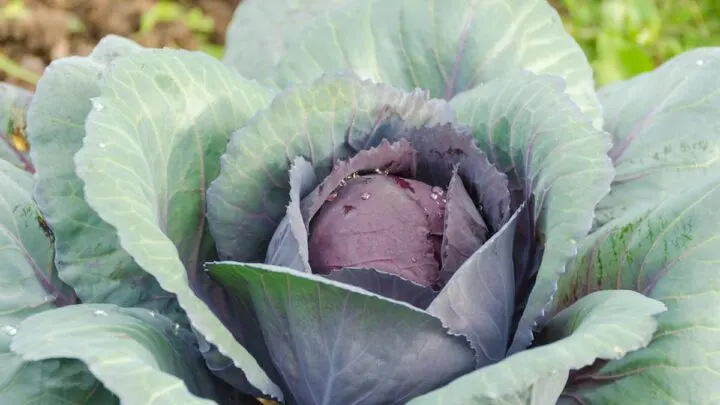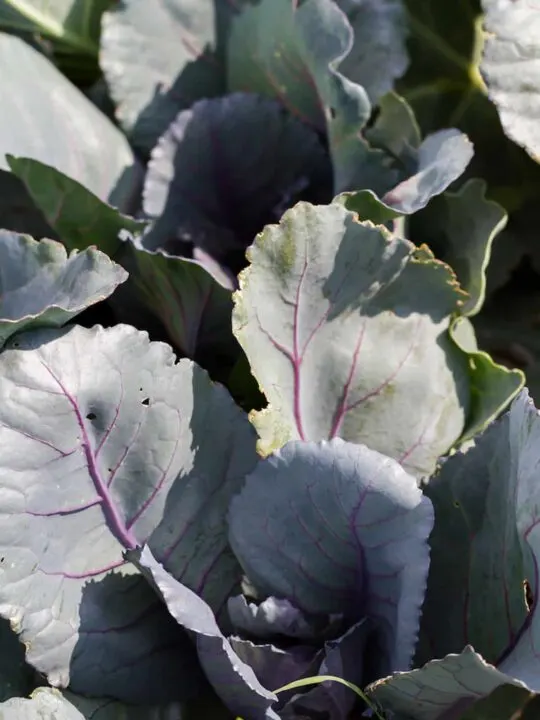Cabbage is a simple and large vegetable that can be chopped up and thrown in many different dishes. As a new gardener or cabbage grower, it may shock you when your cabbage appears to be an odd color. You may be wondering, why is my cabbage purple?
The most common reason that cabbage may be purple is a lack of a particular nutrient. Cabbage plants may commonly be deficient in nitrogen and phosphorus. Secondly, your cabbage may grow too cold or receive inadequate water. Lastly, there’s a possibility you planted red cabbage instead of white, giving it a purple tint and making you believe something is wrong with it.
Continue reading to learn about cabbage and why it may be purple instead of white.

What Causes White Cabbage To Turn Purple?
| Cause | Preventions and Solutions |
| A lack of or excess amount of water-Too much water can rot the roots of a cabbage plant, turning its leaves purple and eventually brown. | Stick your finger into the soil. If it feels damp around 2 inches beneath the surface, then you shouldn’t need to water. If it’s dry, water immediately. |
| A lack of nutrients in the soil- Phosphorus and nitrogen are the most common deficiencies. This is the most common cause of purple colored cabbage leaves. | Use nutrient dense soil from the start and make sure that you are fertilizing your cabbage plants regularly to prevent any deficiencies. |
| Transplanting your seedlings from an indoor setting to an outdoor garden in new soil-This can cause a shock to your cabbage plants. They will temporarily turn to a purple color until they get used to their new climate. | Try placing your seedlings outside for a week or two to get acclimate to the climate before you plant them in the soil. |
| Planting your cabbage too soon; specifically before the last frost- Cabbage can actually withstand a decent amount of cold weather, but too much of it will cause its leaves to turn purple; but that may be temporary. | As soon as the weather warms up again, the leaves should return to a white and light green color. |
| An inadequate pH level- Cabbage plants grow best in soil with a pH of 6.0-7.5. Even a slight issue with acidity can turn your cabbage leaves purple. | Purchase a soil with this level of acidity to plant your cabbage plants. It may also be necessary to buy a pH testing kit to measure your soil acidity on a regular basis. |

Is Cabbage Supposed To Be Purple?
Yes, some cabbages can be purple. The two main types of cabbage are white cabbage and red cabbage. The name red cabbage can be deceiving, but it is more purple than red. Sometimes someone may think they are planting white cabbages and end up shocked when red cabbage begins to grow.
There’s a chance that you could have mistaken the color of the cabbage you planted and that there’s nothing wrong with your cabbage plants.
Red cabbage is a highly nutrient-dense vegetable. It contains high amounts of antioxidants and fiber. Many of the vitamins in red cabbage are known to increase bone health.
Also, because of the high amount of water in it, many believe it creates a feeling of fullness, aiding in weight loss. So, you may have accidentally planted red cabbage, but it has so many benefits. What a great mistake to make.
Ways To Use Purple Cabbage Leaves?
If you’re trying your best and your white cabbage leaves are still turning purple, don’t get too disappointed. You can still use purple cabbage leaves in a few ways.

- Compost them. It may seem like you are throwing them out, but they are rich in nutrients and will break down well into future compost. You will be recycling them to fertilize future plants.
- Feed them to farm animals if you have any. This may include cows, chickens, rabbits, or goats. Animals love leafy food, and cabbage leaves are a great way to nourish them.
- Don’t be afraid to eat them yourself. Just because they are slightly purple doesn’t mean they aren’t edible. Purple cabbage leaves can be thrown into salads and other dishes. They are safe to eat and typically don’t change much in flavor. Treat them as a leafy green.
Final Thoughts
If your cabbage leaves are turning purple, refer to the list at the beginning of this article to decipher what you may be doing wrong in the growing process. One simple issue can turn cabbage leaves purple. Remember to be patient.
After correcting an issue, your leaves may eventually lose the purple color with a little time. Ensure that your cabbage plants receive enough nutrients and adequate water. If you have tried everything and your cabbage leaves are still purple, double-check to ensure you didn’t mistakenly plant red cabbages instead of white.
Overall, don’t be worried if your cabbage leaves are purple. There’s likely a solution; if not, there are still several ways to use purple cabbage leaves.

Hi there, my name is Allie and welcome to my blog; GareningWithAllie!
Much of what you see written here is just our personal experiences with gardening. Along with the content I write here, there is also a unique collection of gardening topics covered by some of our close friends. I hope you find everything you read here to be helpful, informative, and something that can make your gardening journey the most lovely experience ever! With that said, Happy Gardening!
